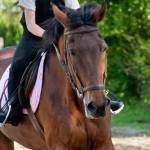Equine Head/Neck Position Influences Balance and Stride

There have always been differing opinions regarding the best position of a horse’s head and neck. It is known that head-neck position (HNP) is related to freedom of movement and loading pattern on the equine locomotor system. Studies have indicated that different HNPs mainly affect movement of the forelegs, and also that the use of draw reins combined with normal reins tends to shift the horse’s balance toward the hindquarters.
In order for a horse to perform to its maximal ability, it must be balanced and comfortable. Each equestrian discipline attempts to put the horse in a slightly different frame, arranging weight-bearing ratios and body position in the best balance to allow the widest range of motion. If a particular HNP shifts the horse’s body weight so as to strain muscles or limit movement, that position would restrict the horse’s performance. Because rider weight impacts the horse’s natural balance, a recent study conducted at the University of Zurich looked mainly at balance and weight-bearing ratios in unridden horses.
Seven Warmblood horses (six geldings, one stallion) were used in the study. The horses had been trained to intermediate (1) or Grand Prix (6) levels of dressage performance. Mean age was 14, and all heights were close to 17 hands. All horses were examined before the study to establish soundness and freedom from back pain.
The horses had a week of training at a walk and trot on a high-speed treadmill in each of six HNPs. The positions were:
- HNP1, unrestrained with loose side reins.
- HNP2, elevated neck, poll high and bridge of the nose slightly in front of vertical.
- HNP3, elevated neck, poll high and bridge of the nose slightly behind vertical.
- HNP4, flexed neck, low head, bridge of the nose considerably behind vertical.
- HNP5, head and neck in extreme high position, bridge of the nose considerably in front of vertical.
- HNP6, head and neck extended forward and downward.
HNP1 was considered the reference position, and data were collected in this position for each horse at a range of velocities. Measurements were started when the horse had reached a regular pace and achieved the predetermined HNP.
Measurements were made of vertical ground reaction force and time parameters for each limb. Stride duration, stance duration, suspension duration, difference in time of paired footfalls in diagonal gait, overreach relative to stride length, and vertical force parameters were measured.
At both walk and trot, preferred speeds were highest for HNP6. At all other positions, preferred speed was slightly lower.
At the walk, ratio of weight on forehand and hindquarters was similar between HNP1 and HNP6. At all other positions, a proportion of weight shifted from forelegs to hind legs, and stride length and overreach were decreased significantly. The same general findings were seen at the trot.
Suspension was increased in HNP2, HNP3, and HNP5, and stance duration was decreased in the forelimbs in HNP2 and HNP5. Overreach was shorter in HNP4 and HNP5 and longer in HNP6. Stride length at the walk decreased in HNP2, HNP3, HNP4, and HNP5.
In an additional trial segment, horses were worked on the treadmill after the addition of a rider. Measurements showed that the weight of a rider tended to load the forelimbs to a greater extent than the hind limbs. Shifts of weight to the hindquarters in ridden horses with various HNPs were similar to those seen in unridden horses but were somewhat less pronounced.
Stride length and overreach decreased with a rider at both walk and trot. At the trot, ridden horses showed a more prolonged contact with the ground for each step.
An increased comprehension of how the horse moves and carries itself should help riders understand how their positioning of the horse’s head and neck makes the horse’s work easier or more difficult to perform. The head and neck comprise about 10% of the total body mass, and therefore extension of the head and neck can be expected to shift the center of mass forward, while shortening the neck can be expected to shift the center of mass toward the horse’s rear. The authors stated that, in addition to these mechanical results, a horse could be expected to develop reflex tension in the muscles of the back when riders impose unnatural positions of the head and neck such as those adopted in HNP4 and HNP5. These positions also produced greatest decreases in stride length and overreach, with the changes possibly related to back stiffness in HNP5.
Positions that shorten ground contact time also induce a higher rate of loading for each footfall. The study of stress reduction strategies in horses and humans has suggested that relief of stress results from distributing a given impulse over a longer contact time. In general, motion patterns that are the least stressful for the musculoskeletal system may be related to prevention of injuries, according to this study report.
It should be noted that rider position, maturity of the horse, stage of training and condition, and requirements of each riding discipline are so varied that there is likely no ideal HNP that will eliminate all stiffness and muscle tension and allow free, natural movement for every horse at all times. However, a general conclusion indicates that riders who induce a tightly flexed neck with an artificially high or low head position may cause their horses to work harder and tire more quickly than when the head and neck are allowed to assume a more natural position.








